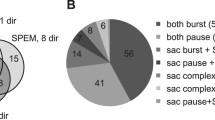Abstract.
The complex spike (CS) and simple spike (SS) activities of Purkinje cells in the rostral zone of the cerebellar flocculus were recorded in alert cats during optokinetic responses (OKR) elicited by a stimulus sequence consisting of a constant-speed visual pattern movement in one direction for 1 s and then in the opposite direction for 1 s. The quick-phase-free trials were selected. Ninety-eight cells were identified as rostral zone cells by the direction-selective CS activity that was modulated during vertical but not horizontal stimuli. In most of the majority population (88 cells), with an increasing CS firing rate during upward OKR and an increasing SS rate during downward OKR, the inverse dynamics approach was successful and the time course of the SS rate was reconstructed (mean coefficient of determination, 0.70 and 0.72 during upward and downward stimuli, respectively) by a linear weighted superposition of the eye acceleration, velocity, position, and constant terms, at a given time delay (mean 10 ms) from the unit response to the eye-movement response. Standard regression coefficient (SRC) analysis revealed that the contribution of the velocity term (mean SRC 0.98 for upward and 0.80 for downward) to regression was dominant over acceleration (mean SRC 0.018 and 0.058) and position (–0.14 and –0.12) terms. The velocity coefficient during upward stimuli (6.6 spikes/s per degree/s) was significantly (P<0.01) larger than that during downward stimuli (4.9 spikes/s per degree/s). In most of the minority population (10 cells), with both CS and SS firing rates increasing during upward OKR, the inverse dynamics approach was not successful. It is concluded that 1) in the cat rostral zone Purkinje cells, in which the preferred direction is upward for CS and downward for SS, eye velocity and acceleration information is encoded in SS firing to counteract the viscosity and inertia forces, respectively, on the eye during vertical OKR; 2) the eye position information encoded in SS firing is inappropriate for counteracting the elastic force; 3) encoding of eye velocity information during upward OKR is quantitatively different from that during downward OKR: SS firing modulation is larger for upward than for downward OKR of the same amplitude; and 4) encoding of motor dynamics is obscure in cells in which the preferred direction is upward for both CS and SS.
Similar content being viewed by others
Author information
Authors and Affiliations
Additional information
Electronic Publication
Rights and permissions
About this article
Cite this article
Mizukoshi, A., Kitama, T., Omata, T. et al. Motor dynamics encoding in the rostral zone of the cat cerebellar flocculus during vertical optokinetic eye movements. Exp Brain Res 132, 260–268 (2000). https://doi.org/10.1007/s002210000363
Received:
Accepted:
Issue Date:
DOI: https://doi.org/10.1007/s002210000363




